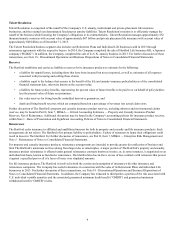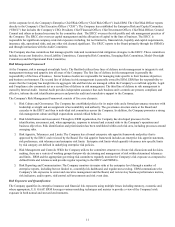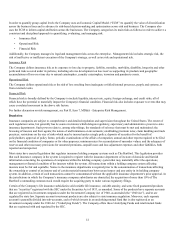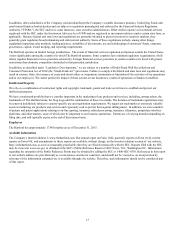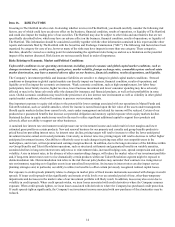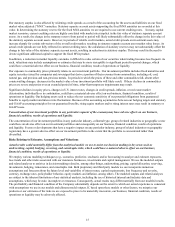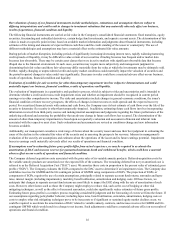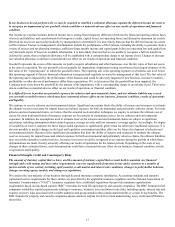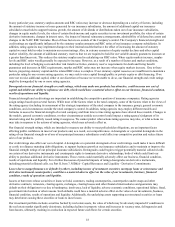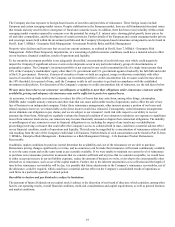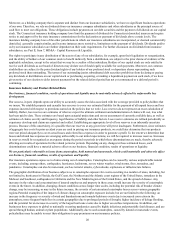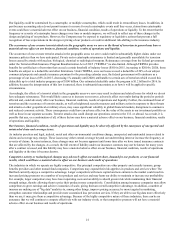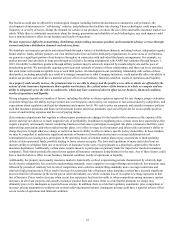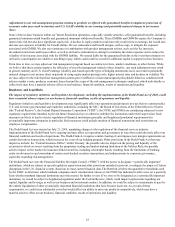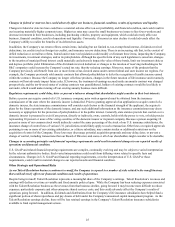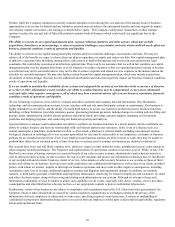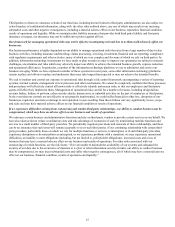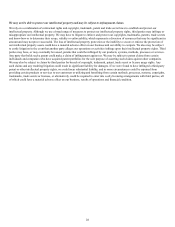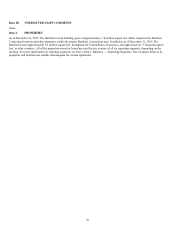The Hartford 2015 Annual Report Download - page 19
Download and view the complete annual report
Please find page 19 of the 2015 The Hartford annual report below. You can navigate through the pages in the report by either clicking on the pages listed below, or by using the keyword search tool below to find specific information within the annual report.19
The Company also has exposure to foreign-based issuers of securities and providers of reinsurance. These foreign issuers include
European and certain emerging market issuers. Despite stabilization in the European market, there are still fundamental structural issues
that remain and may result in the re-emergence of fiscal and economic issues. In addition, there has been recent volatility within certain
emerging market countries spurred by concerns over the potential for rising U.S. interest rates, slowing global growth, lower prices for
oil and other commodities, and the devaluation of certain currencies. Further details of the European and certain emerging market private
and sovereign issuers held within the investment portfolio and the Company's European based reinsurance arrangements can be found in
Part II, Item 7, MD&A - Enterprise Risk Management - Investment Portfolio Risks and Risk Management.
Property value declines and loss rates that exceed our current estimates, as outlined in Part II, Item 7, MD&A - Enterprise Risk
Management - Other-Than-Temporary Impairments, or a worsening of global economic conditions could have a material adverse effect
on our business, financial condition, results of operations and liquidity.
To the extent the investment portfolio is not adequately diversified, concentrations of credit risk may exist which could negatively
impact the Company if significant adverse events or developments occur in any particular industry, group of related industries or
geographic regions. The Company’s investment portfolio is not exposed to any credit concentration risk of a single issuer greater than
10% of the Company's stockholders' equity other than U.S. government and U.S. government agencies backed by the full faith and credit
of the U.S. government. However, if issuers of securities or loans we hold are acquired, merge or otherwise consolidate with other
issuers of securities or loans held by the Company, our investment portfolio’s credit concentration risk to issuers could increase above
the 10% threshold, for a period of time, until the Company is able to sell securities to get back in compliance with the established
investment credit policies. For discussion of the Company’s exposure to credit concentration risk of reinsurers, see the risk factor below.
We may incur losses due to our reinsurers' unwillingness or inability to meet their obligations under reinsurance contracts and the
availability, pricing and adequacy of reinsurance may not be sufficient to protect us against losses.
As an insurer, we frequently use reinsurance to reduce the effect of losses that may arise from, among other things, catastrophes,
GMDB's under variable annuity contracts and other risks that can cause unfavorable results of operations, and to effect the sale of one
line of business to an independent company. Under these reinsurance arrangements, other insurers assume a portion of our losses and
related expenses; however, we remain liable as the direct insurer on all risks reinsured. Consequently, ceded reinsurance arrangements
do not eliminate our obligation to pay claims, and we are subject to our reinsurers' credit risk with respect to our ability to recover
amounts due from them. Although we regularly evaluate the financial condition of our reinsurers to minimize our exposure to significant
losses from reinsurer insolvencies, our reinsurers may become financially unsound or dispute their contractual obligations. The inability
or unwillingness of any reinsurer to meet its financial obligations to us, including the impact of any insolvency or rehabilitation
proceedings involving a reinsurer that could affect the Company's access to collateral held in trust, could have a material adverse effect
on our financial condition, results of operations and liquidity. This risk may be magnified by a concentration of reinsurance-related credit
risk resulting from the sale of the Company’s Individual Life business. Further details of such concentration can be found in Part II, Item
7, MD&A - Enterprise Risk Management - Reinsurance as a Risk Management Strategy - Life Insurance Product Reinsurance
Recoverable.
In addition, market conditions beyond our control determine the availability and cost of the reinsurance we are able to purchase.
Reinsurance pricing changes significantly over time, and no assurances can be made that reinsurance will remain continuously available
to us to the same extent and on the same terms as are currently available. If we were unable to maintain our current level of reinsurance
or purchase new reinsurance protection in amounts that we consider sufficient and at prices that we consider acceptable, we would have
to either accept an increase in our net liability exposure, reduce the amount of business we write, or develop to the extent possible other
alternatives to reinsurance, such as use of the capital markets. Further, due to the inherent uncertainties as to collection and the length of
time before reinsurance recoverables will be due, it is possible that future adjustments to the Company’s reinsurance recoverables, net of
the allowance, could be required, which could have a material adverse effect on the Company’s consolidated results of operations or
cash flows in a particular quarterly or annual period.
Our ability to declare and pay dividends is subject to limitations.
The payment of future dividends on our capital stock is subject to the discretion of our board of directors, which considers, among other
factors, our operating results, overall financial condition, credit-risk considerations and capital requirements, as well as general business
and market conditions.


